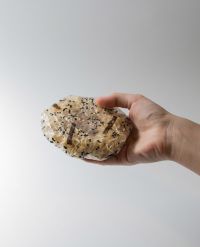
The packaging consists of a flavourless biofilm, which is made from only a handful of readily-available ingredients including potato starch, glycerin and water. "I was able to do all the testing and manufacture in my kitchen as the process is very simple," explained Grounds. She was motivated by the many long days and nights she spent studying, which were fuelled by packets of instant ramen often containing "more plastic than noodle". Once it has been heat sealed, the film keeps the dry noodles from going stale. But as soon as it comes into contact with boiling water it dissolves in less than a minute. With herbs and flavourings embedded into the packaging the resulting liquid effectively acts as the sauce, while ingredients such as dried shrimp are stored loosely in the packs before being released into the broth. "The film ingredients are blended and heated until the mixture is at the right thickness. At this point, I add the spices and flavourings before pouring it into a mould to set for 24 hours." The resulting film is then wrapped around the dried noodle blocks, which are made into doughnut shapes to allow them to cook more evenly and fit more easily into a bowl. For hygiene purposes, the filled wrappers are stored in a wax-coated paper sleeve. (This may detract a bit from the greener credentials of the dissolvable plastic we think: AIPIA). Her dissolvable wrapper was conceived as an alternative to the mountain of single-use plastic, as well as its bioplastic substitutes, which she says often fall short of their promises. "While other bio-based alternatives to plastic claim to be compostable or biodegradable, from a consumer perspective, it's not always that simple," Grounds told Dezeen, a leading design magazine. "Many of the emerging bio-based films only break down in an industrial composter at 50?C, so they often end up in the wrong place without the consumer really knowing that they caused damage to the planet,” she said. "The issue is that the world is not only confronting a rapidly growing mountain of plastic but also an even greater mountain of apathy. That's why it was important to me to make the convenient choice the sustainable one. If the quick option for meals or snacks is eco-friendly, consumers can help the planet perhaps without even knowing." AIPIA says: Well it may not be anywhere near commercial level yet. But it is most certainly a Smart piece of packaging and we’d love to try it!







